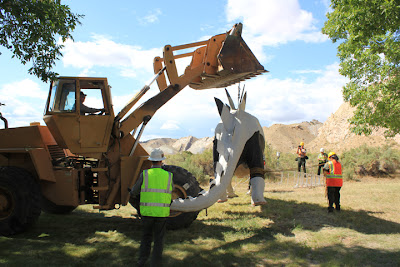Here at Dinosaur National Monument we have our own dinosaur migration and although it only involves one specimen of a single species, it is of immense significance. A mere 18 months or so ago, our life-sized Stegosaurus model underwent an arduous migration of nearly ¾ of a mile from the closing temporary visitor center to the west border of the Green River Resource Center. Now, as the end of the building rehab projects at Dinosaur approaches, it’s time for this beast to once again prepare to greet visitors.
To prepare it for its move, we first remove the long anchoring spikes in each of the footplates.
Next an eyebolt is threaded between the dorsal plates and into the internal armature.
A chain is attached to the eyebolt and a front end loader and the Stegosaurus is gingerly lifted up.
Ropes are slung around the legs to stabilize it during transport.
Then, as Jackie Gleason so famously said “….and away we go!”
Fortunately we don’t have to move it cross country but can take a paved road to the new Visitor Center at the bottom of the hill (not the visitor center enclosing the Carnegie Quarry).
Once there, it is placed in its new display area in front of the building and, given the known proclivities for wanderlust in Stegosaurus, the feet are pinned to the ground.
All visitors who come to the Monument will pass by this ancient reptilian plant-eater with a walnut-sized brain.
However, as constant readers are well aware, our Stegosaurus made a more spectacular migration nearly 50 years ago. In 1963, our model (along with models of Tyrannosaurus, Apatosaurus, Ankylosaurus, Coelophysis, Corythosaurus, and Hadrosaurus) rode a barge across New York Harbor on their way to a 2 year stint at the Sinclair Oil Company Exhibit at the 1964 World’s Fair in Flushing Meadows, New York. That’s our model third from the right.
After the World’s Fair ended, the Sinclair dinosaurs toured the US. Here’s our Stegosaurus at the East Hills Shopping Center in St. Joseph, Missouri.
Eventually the Stegosaurus-that-could arrived at Dinosaur National Monument where for the next half-century it met visitors coming to look at its remains and those of its contemporaries.
Now that it is back in place, things can start to go back to normal. So in recognition of this great moment, raise a glass to the next half-century, Salut!
Literature Cited
Woodward H.N., Rich T.H., Chinsamy, A., and Vickers-Rich, P. 2011 Growth Dynamics of Australia's Polar Dinosaurs. PLoS ONE 6(8): e23339. doi:10.1371/journal.pone.0023339
Photos:
NY Harbor and Missouri: http://www.monsterbashnews.com/SinclairDinosaurs.html
All others: NPS












Since the sculpture is literally old-school with dragging tail and sprawling posture, why the speculative paleo-hipster camo paint job? The model is a museum piece representative of an historic watermark in paleontological thinking. I think this repainting is akin to having someone repaint Charles R. Knight murals with modern speculative coloring.
ReplyDeleteYou raise an interesting question and present an interesting viewpoint. While our Stegosaurus model is somewhat dated, it is really not all that bad. It is more accurate than many of the other Sinclair models from the world’s fair, such as the hadrosaurs and the T. rex which are restored in an upright, human-like, bipedal pose. Details of muscle mass, skin wrinkles, etc. are on our model and give it quite a life-like look when seen up close. We hope that a repainting in the future will better bring out those subtle features. I have certainly seen more recent, but much worse, life-size Stegosaurus models.
ReplyDeleteAs for the appropriateness of the color pattern, well that depends on what you see the model’s function to be. At Dinosaur we aim to stimulate people to think about dinosaurs as living animals with complex behaviors and biology. The model is the only one we have so we use it to that end. We do not want to present the model as an example of past thinking or as some kind of historical curiosity because we do not see ourselves as that kind of historical museum. One could certainly do that and repaint the model to look as it did in 1963. That’s just not what we see our mission to be.
As for the “paleo hipster” pattern itself, there is some rationale behind it. Stegosaurus is a pretty big terrestrial vertebrate, bigger than most living terrestrial mammals. It’s probably at the upper limit of size where one can blend into the background. So the present pattern suggests a different strategy for trying to avoid the beady eyes of Allosaurus, Tarbosaurus, and Ceratosaurus, all large predatory dinosaurs found in the Carnegie Quarry. We’ve based it on the gemsbok, a large antelope in South Africa. This color pattern is a disruptive pattern, where contrasting blotches of color serve to break-up the outline and separate the body into unrelated segments. Kildeer shorebirds have a similar pattern. It can be surprisingly effective in making an animal “disappear”. Do we know that Stegosaurus had a disruptive pattern? No. It is just an attempt, with some logical basis, to present dinosaurs in a way that might challenge visitors and stimulate them to ask questions and learn more.
I never realized that the stego was originally part of the Sinclair exhibit! I like the new colors on the stego. Just one other question....what's up with the long hair and handlebar mustache Dan!
ReplyDeleteMiss working with all of you and will miss the old round building!
Kathy Bishop
Page, Arizona
Stumbled on this page while looking for information about the stegosaurus model at the Milwaukee Public Museum, and color innovations notwithstanding, this dino model bears an amazing resemblance. Did Sinclair make multiple stegosaurus models? Any info you have would be very much appreciated. Thanks!
ReplyDeleteI've seen the Sinclair Tyrannosaurus and Apatosaurus at Dinosaur Valley State Park in Texas. This would have been in 1994, but I understand the models are still there. The following link is an article from 1970 stating where most of the Worlds Fair dinosaurs ended up. http://www.worldsfairphotos.com/nywf64/articles/misc/abilene-7-14-70.jpg
ReplyDelete